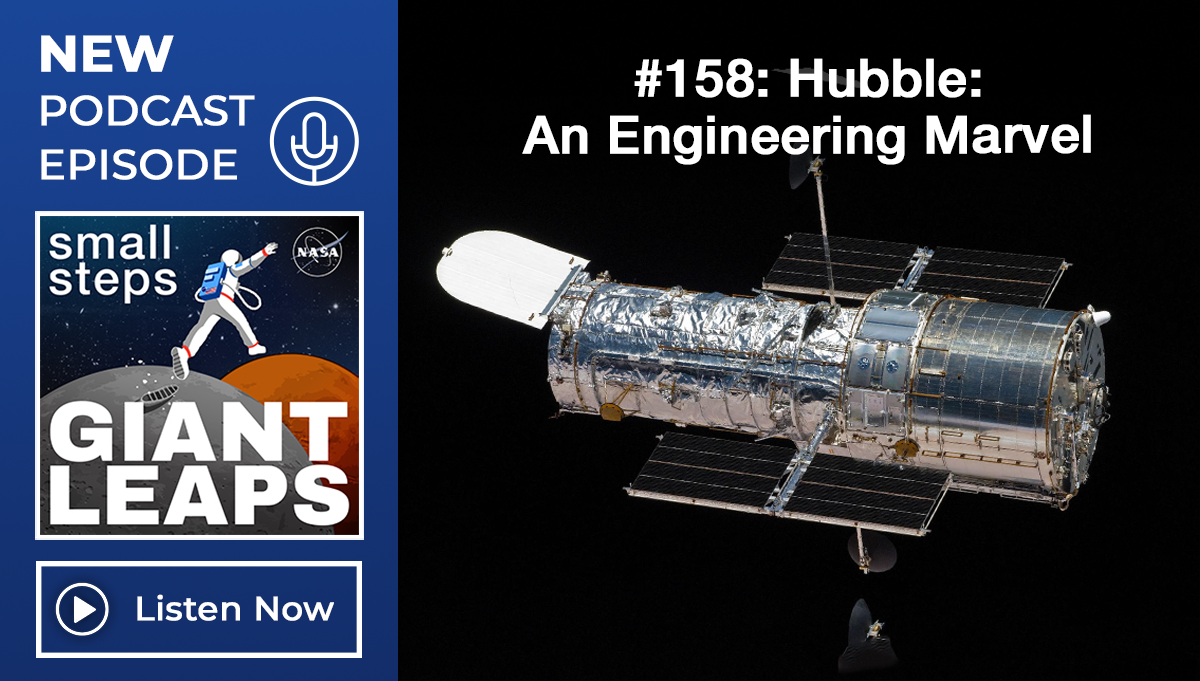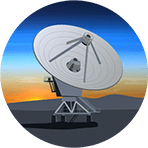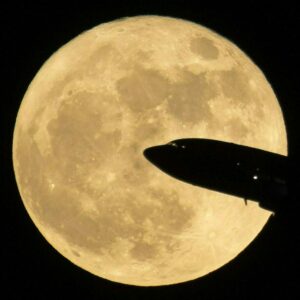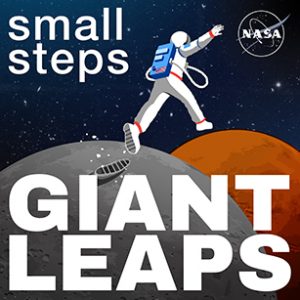NASA photographer Bill Ingalls talks about his journey documenting history for the agency, stakeholders, and the public.
Ever wondered what it takes to capture NASA’s most breathtaking moments? From rocket launches to behind-the-scenes astronaut training, Bill Ingalls, senior contract photographer for NASA Headquarters has spent decades framing history through his lens. In this episode, we dive into his journey, how he and his team prepare for assignments, and the importance of visual storytelling.
In this episode, you’ll learn about:
- The power of imagery
- Applying lessons learned
- How NASA ensures photographs maintain integrity

Credit: NASA/Joel Kowsky
Bill Ingalls is the senior contract photographer at NASA Headquarters, where he has spent decades captured images from many of NASA’s most iconic moments. Since joining NASA in 1989, Ingalls has documented historic spaceflights, aeronautics milestones, planetary science missions, and the human side of exploration.
Ingalls has traveled worldwide to photograph NASA’s milestones, from remote launch sites to behind-the-scenes moments with astronauts and engineers. His work has been widely published and he was won multiple industry and agency awards.
Resources
NASA Headquarters Flickr Account
NASA Images Page
Best 100 NASA HQ Photos of 2024
How to Photograph the Moon
Courses
Transcript
Andrés Almeida (Host): Welcome to Small Steps, Giant Leaps, the podcast from NASA’s Academy of Program/Project and Engineering Leadership or APPEL. In each episode, we dive into the lessons learned and experiences of the people behind NASA’s innovative missions and research.
Capturing NASA’s most iconic moments takes more than just a good camera. It takes experience, timing and a sharp eye. There are teams of talented photographers all across the agency. Bill Ingalls, senior photographer for NASA Headquarters in Washington has spent decades behind the lens. Has spent decades behind the lens documenting everything from rocket launches to meetings with presidents. Bill is here to share with us his journey into photography, how AI can be a valuable tool if used correctly, and the importance of visual storytelling to get the message out.
Hey, Bill, thanks for being with us.
Bill Ingalls: Thank you for having me. I appreciate it.
Host: How did you get started in photography and what led you to NASA?
Ingalls: Yeah, I went to a small university outside of Pittsburgh. Was Waynesburg College back then, it’s now Waynesburg University. And I was struggling with what I wanted to do with my life as an adult, and my father, who I give great credit to, said, “You should do what you want to do what you find interesting, because you’ll be very good at it if you have a passion for it. However, I do encourage you to get a college degree to support that.”
So, in college, I went ahead and pursued visual communications, which encompassed television and photography and graphic arts at the same time, I took a lot of English classes because I felt I needed to make up for being a little bit of a wild child in my earlier years, and before I knew it, ended up with a second degree in English. So, I ended up graduating with a visual communications degree in English.
There was an alumni weekend, as many colleges have, and one of the alum ran the then-called Broadcast and Imaging Branch at NASA Headquarters, and he offered the school to have an internship one summer in his office. And I thought that would be a great idea. I was very intimidated by it, though. I learned about two or three other others in my college that were competing. Our college made us compete for internships, which I thought was kind of cool, and I knew the caliber of the people I was up against, so I didn’t think I really had a chance, just because their writing skills were so good. But I stuck it out.
And before I knew it, my counselor brought me in and said, “Well, congratulations, you’ve got the internship.” And I said, “How is that possible? I mean, thank you.” But he said, “Well, there might be a lesson to be learned here. Everyone was so intimidated by this internship that everyone dropped out. But you, you just stuck it out. You’re off to NASA for the summer.” Yeah.
So, just to add to that, it’s again, it was a great lesson in that. But as far as getting into photography itself, I had a dear friend that was really into photography and had his own dark room and I had never done any dark room photography before, even though my grandfather was very serious about photography and made a side living doing it as well.
But my first day in his dark room, not knowing anything about how it worked, he had a box of paper that you print on, which is light sensitive, of course, and of course, in broad daylight, I opened the box and said, “What do you do with these?” And he said, “Nothing now. You throw them in the trash because you just ruined sheets of paper.” [Laughter] Okay, lesson learned! My entire career has been things like that, where I’ve learned the hard way.
Host: Well, we’re big on lessons learned here.
You cover a lot of different assignments. Is there such thing as a typical day for a NASA photographer?
Ingalls: That’s a good question. I think if you ask that question of all photographers, even just across NASA, you would get quite a different set of answers on what they do day to day. In my office here in Washington, DC, I’m very blessed to have a talented team that – well we all wear multiple hats. We’re not just photographers. I’m a supervisor of the team and a photographer, senior photographer, and then I’ve got, you know, on our team, photo archivist-slash-photographer, photo editor-slash-photographer, photo researcher slash photographer.
And so everyone has multiple hats, but when you talk about the photography side of things itself, there’s a lot of prep that goes into our assignments when we have the opportunity to do the prep, which very often we do, actually, and that can involve learning about the mission, recovering, sitting in a mini NASA meetings to just be aware of who the key players are, what the goal of the mission is, the timeline of everything. Then we start to prep our gear that we’ll be needing for that, thinking about that. Perhaps if there’s travel involved, working logistics, customs issues, and then, of course, there’s all the metadata that goes along with our imagery. And that is preparing captions, finding out names and titles of people that will be involved.
So, the more prepared we can be going into an assignment, the quicker we can be about getting those images turned around and shared with the world afterwards, and the more comfortable we can become inflexible during the assignment itself. So a typical day is a lot of prep, a lot of being aware in a lot of meetings and so forth.
Host: So how do you balance technical accuracy with the artistic expression that you want to deliver in your photos?
Ingalls: With the equipment we use these days, there’s quite a learning curve. And as technology advances, our equipment advances, there are more and more features on cameras than we’ve ever had in our days, more customization of cameras. I can literally assign a button on a camera to do anything I want almost, these days, and so while a colleague in the office may be using the exact same model, it could be a totally different beast when I pick it up, because they’ve customized it. So, part of our job is learning our gear as best we can.
So, the last thing you want to be doing when you’re out in assignment is fumbling staring at your camera going, how do I make it do this or that? So, getting comfortable with the technology (and that’s the camera, that’s the editing software as well, the distribution tools that we use) all of those things trying to get to a certain level of proficiency so that you’re not having to worry about that when the moment counts.
As far as the artistic expression of imagery, you know, I think we’ve got a responsibility that the entire team takes very seriously, and that is that we are the eyes for those that can’t be there where we are, and so we want to inform them about what’s happening. And that is to, to be able to make imagery that’s clear and understandable. And yet, as you say, using the word “artistic,” if you’ve covered your bases in the most basics of photography, you might want to, well, not might we do want to – include some “artistic imagery” (not the word I necessarily use) but maybe creative and a little different. And to me, that’s an image that maybe is not readable instantly. It takes you to spend a little bit of time exploring that image, to see what’s going on and consider and it’s engaging, and that’s part of what we want to do, is engage with people.
Host: That’s important, because that’s how, like you said, you communicate the agency’s work, not just to the public, but to stakeholders, and I’m sure the workforce as well.
Ingalls: That’s right, exactly, yeah. And again, we’re kind of between two worlds, and the fact that we’re often reporting out news in some immediacy, but we’re also recording history, so you want these images to be understandable to future generations as well, and not so stylized in such a way that that they they don’t have that ability for a shelf life.
Host: You probably have a lot of discussions with your team on artificial intelligence and how advances in that technology and social media kind of shape your, your work, not just over the years, but right now. What are you seeing?
Ingalls: Yeah, oh, that’s, that’s…we could spend hours on that one question right there alone.
AI itself, just to address that. Generative AI, to define it more specifically, is in the eyes of what our team does is a no-no zone. Just, we don’t go there. Again, if we are trying to build trust with the American taxpayer and the world, for that matter, and what we publish, we have to be honest about what we’re doing. And you know, adding backgrounds, removing things through AI, generative AI is just against our policy.
There are other AI tools that are not of this ilk, like noise reduction and, and things like that that are very powerful and we’re looking forward to AI when it comes to search capability. AI to be able to index images and to recognize faces and colors in objects. We already see this and some tools that are out there where I can say, “You know, amongst our 200,000 images,” let’s say, “Show me ones that have a lot of green and blue in them, because I’m working with something I want that color theme.” AI will be very powerful for us. In that regard, our team, outside of AI does spend a lot of time reviewing our editing and talking about what we find acceptable. As far as, where do we cross the line? No, we don’t think that’s acceptable in editing, et cetera. And for the most part, we try to stick to what photojournalists stick to when it comes to editing.
Host: I think many people would like to know what are some of the most challenging or rewarding moments you’ve photographed during your career at NASA, and we’ll share links and photos on the website.
Ingalls: Yeah, I look at every assignment as basically challenging, even, even just doing portraits that we do on a routine basis. You know, I approach them all…I guess I’m fortunate. And I would, I would say my colleagues are blessed and cursed with the same problem, and that is that we really love photography, and we want to do our best, and we, we have a passion for it. So even those things that may seem mundane, we approach with full enthusiasm and interest.
And, you know, one of the things I talk about is, you know, a challenge is, you know, we often have press conferences in the NASA Headquarters auditorium. Well, that auditorium doesn’t change much the shape of it. You know, the lighting changes a little bit, maybe the backdrops ever so slightly, but for the most part, it’s kind of the same. And I find that to be a fun challenge, where, okay, “What can I make that’s kind of unique in this press conference, to make an interesting image? And then, of course, back to what we talked about earlier. Of course, documenting it as we should, to tell the story. Rewarding is when you pull that off.
And also rewarding of the happy accidents. I can’t tell you how many times I’ve meant to do something set out to I have an idea of what an image should be in my mind, and it doesn’t come to fruition. But lo and behold, something else comes to be. I think of the full moon rising behind the Lincoln Memorial I did years ago, super, supermoon. I had mapped out a position and thought that it would be ideal, and I had this vision for what the image would be. And I went home that night with my head hung low because I thought that image was terrible. And then I released it, and it went nuts, and it made me rethink, “Okay, was the image I had in mind going to be better than this? Maybe not, maybe not so.”
And also, literally accidents, where I was doing a long exposure photo of a Soyuz on the launchpad, and I had this setup. It was kind of a new thing for me doing this. And the blast from the rocket knocked that tripod over, but it maintained its aim on the rocket streak, and it produced this really cool image. So, I was like, “You know what? Let’s try to do that for real next time.” And it became a kind of a tool in the toolkit. So, yeah, lots of challenges and lots of rewards.”
Host: Fascinating. You and your team photograph from helicopters and recovery ships out in the open ocean. What sort of trainings do you have to take?
Ingalls: Yeah, great question. Again, I’ll speak specifically to our team in Washington. Training can be very different depending on where you are and what you’re doing. Our team doesn’t work with hazardous materials too much, so we don’t have all of the extensive training for that, but we are at launchpads and in other areas where there are some of those hazardous items you need to be aware of.
So we, we do have annual training, and every other year training that we have to take for, you know, donning emergency escape breathing apparatus and knowing our way around to be able to find the muster point, the gathering point, if you will, for evacuees at different centers. Those are certifications we have to keep on.
For helicopters, we have to do HUET training, which is helicopter underwater escape training, which is, you know, they put you in a fake helicopter and strap you to the seats and dunk you in the bottom of a swimming pool, turn it upside down. You have to push a window out and escape, and that can be rather harrowing, but….and then we have to have physical exams as well. I’m slightly longer in the tooth, so I have to have that every year. They just love to see me and check on me, make sure I’m still good. Luckily, I’m still passing, so, and then we’ve also done some climbing certifications as well.
Host: Do you share knowledge between other photographers at different centers?
Ingalls: Yes, absolutely, and probably more so today than we ever have. So again, photographers across the agency are doing different things. We have scientific photographers. We have photographers that you know specifically are doing wind tunnels and in engineering photography, we have public affairs photographers, which is more like myself and my colleagues, and lots of varying degrees in between those two.
But we do have commonalities across this in tools we use for capturing images, editing images and distributing images. So, we do try to help each other, and I find that for the most part, that works out very well, and we’re always learning from each other as the technology grows as well.
Host: Bill, one final question for you, what do you consider to be your giant leap?
Ingalls: Ah, hence the name of the podcast, yes. Okay.
You know, I would probably have to go back to college and the internship, and then when I finally was offered a position at NASA, about a year later, as a contractor to NASA, I had a lot of fear. Am I good enough? Can I really do this job? You know, it was, it was a move to a city where I didn’t know anyone, and I had great friends that surrounded me and said, “You’ve got this. You need to do this. You will, you will kick yourself down the road, if you don’t take a chance and just try it. You can do it.” And to me, that was a big leap. If left to my own devices, I don’t know that I would have done it, but having people encourage me and saying, “You can do it,” yeah, that was, that was my giant leap. That got me rolling.
Host: Well, Bill, thanks for your time.
Ingalls: Thank you, have a great one.
Host: That’s it for this episode of Small Steps, Giant Leaps. For more on Bill and the topics we discussed today, visit our resource page at appel.nasa.gov. That’s A-P-P-E-L dot nasa dot gov. And don’t forget to check out our other podcasts who are coming back with new seasons this year. That’s Curious Universe, Houston, We Have a Podcast, and Universo Curioso de la NASA. Thanks for listening.
Outro: Three, two, one. This is an official NASA podcast.







